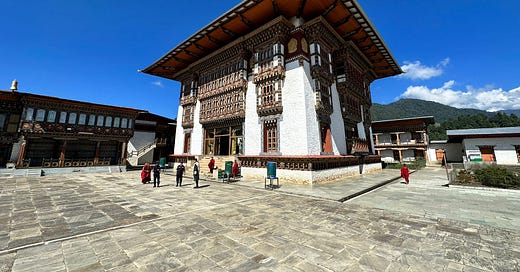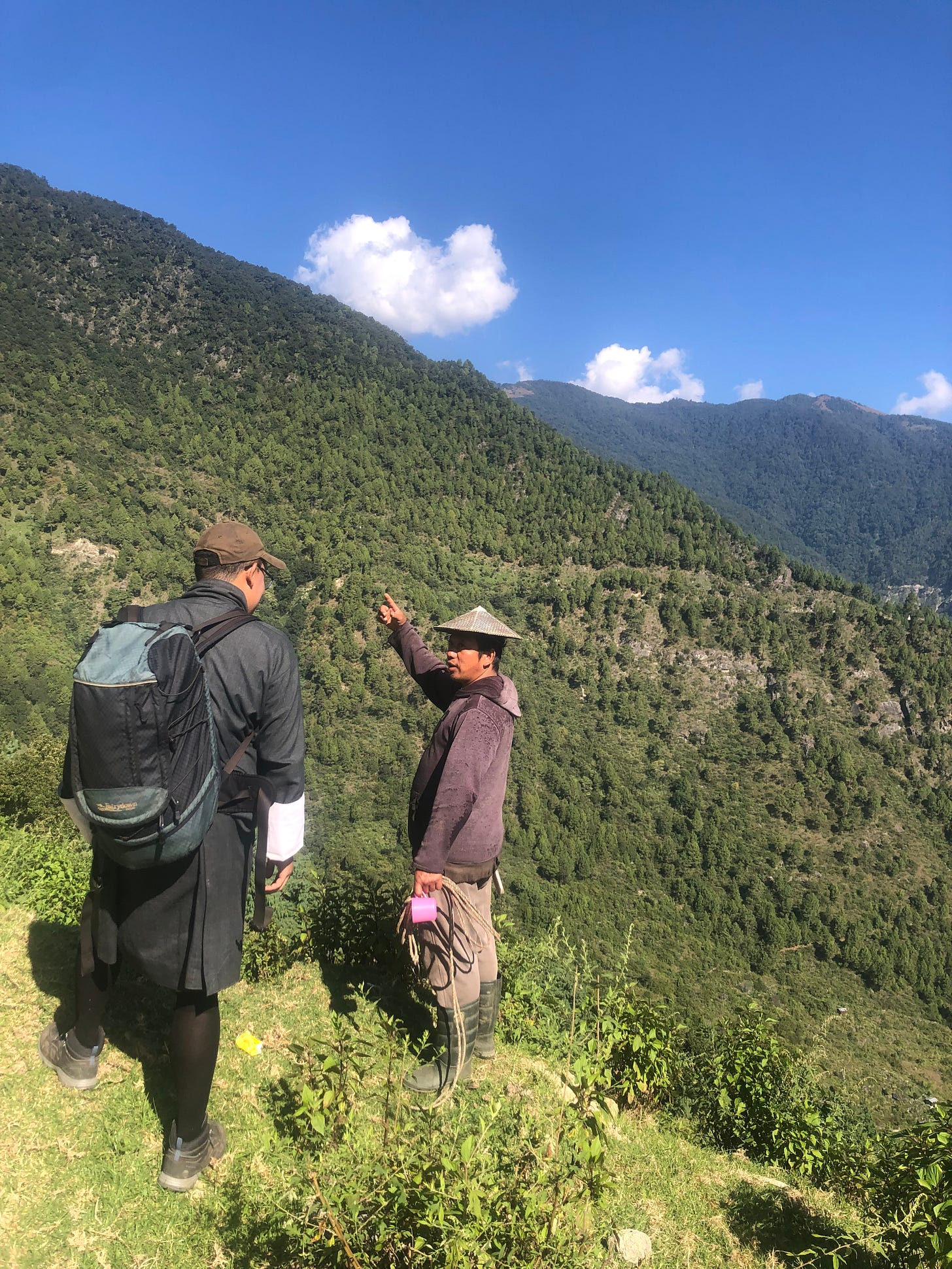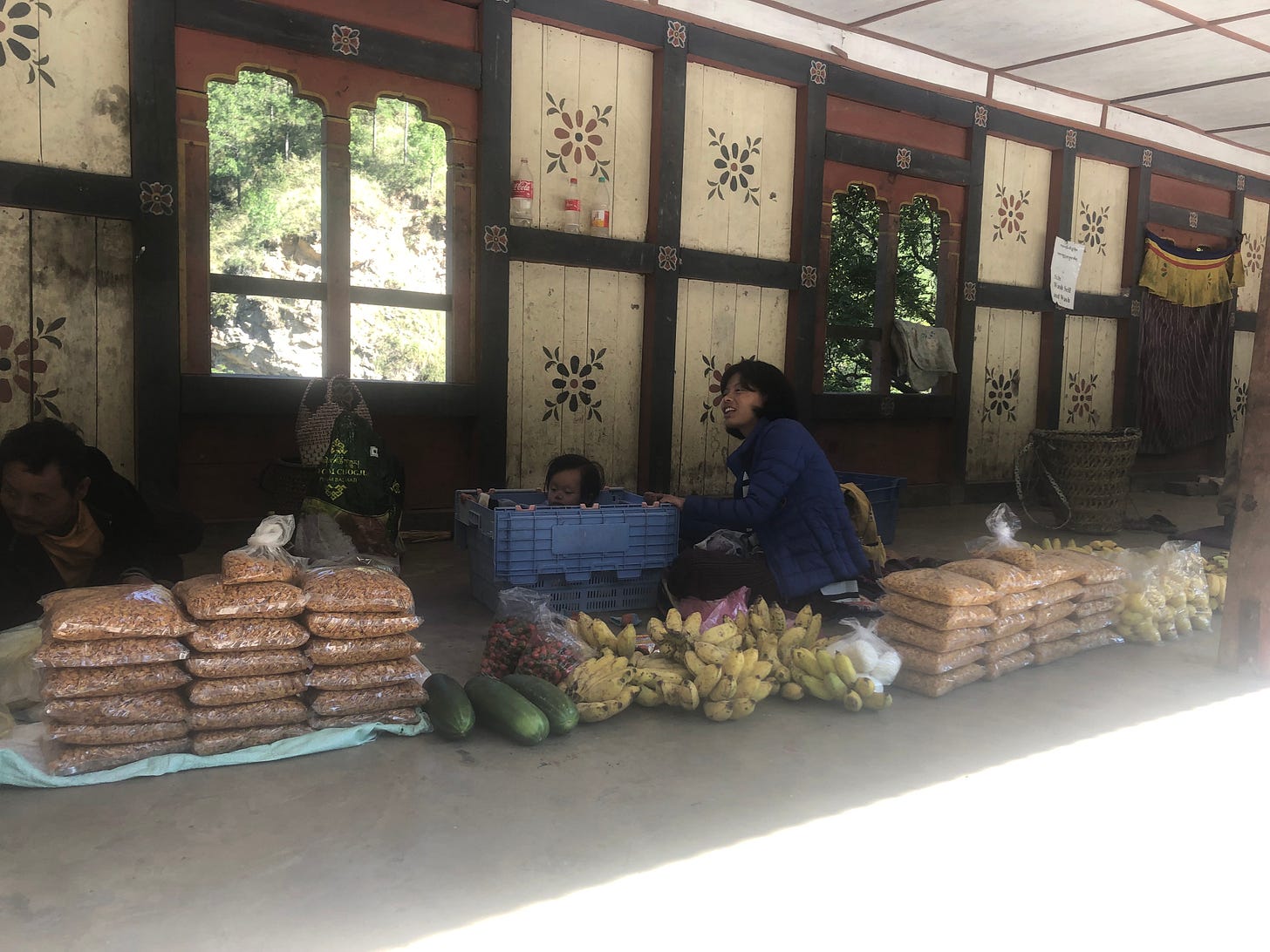multi-storied #26: The travel writer's dilemma
A few years ago, I received an email from a scholar named Tim Hannigan, who said he was working on a PhD thesis about travel writing. He was interviewing practitioners about the genre, he said, and so we met in Dublin and spent a very chatty three or so hours in a pub around the corner from my house. Hannigan was a very sharp analyst of the bigger themes and ideas underlying both the practice and the history of travel writing, and I thought he wanted a few comments from me about my own experiences. Imagine my shock, then, on finding A WHOLE CHAPTER on our conversation in Hannigan’s eventual book: 12 whole MS Word pages of my untidy thoughts and horrendous bloviations. (He describes me as “a small man in his mid-thirties, with a neatly trimmed black beard…and a broad forehead.” Accurate enough, although where oh where did the mid-thirties go?)
Let this one chapter not deter you; Hannigan’s book is excellent, and I greatly enjoyed his other chapters with writers like Kapka Kassabova and Colin Thubron. One of the themes that recurs, unsurprisingly, is about travel writing in the age of the Internet—in the age of a medium that brings you a 4K-sharp immediacy of distant lands. How can a classic travel writer—a describer of places—ever hope to compete? One way (of many), I suggested, was for travel writers today to stay close to journalism: to interview and go deep, rather than to skim for impressions. The latter is the mode that is closer to that of the canonical Western travel writers: Bruce Chatwin, say, who wandered through Patagonia, picking up stray conversations here and there, deploying a vivid lexicon for his surroundings, but otherwise remaining quite self-absorbed through it all. There is now a one-hour YouTube video on the fjords of Patagonia, concocted just for the purpose of “scenic relaxation.” A vivid lexicon alone does not cut it anymore.
But. But. But. Occasionally a chance comes along to go somewhere that is still somewhat hidden from the rest of the world, and that offers a chance to engage in an older-fashioned style of travel writing, which has its own pleasures, particularly for the writer. Last October, I went to eastern Bhutan, where tourism has only recently been permitted. I wrote about the trip for Conde Nast Traveller. The text is below, but don’t miss Hashim Badani’s glorious photos on the website:
Stories travel the way people travel. Following the same paths, that is, and noticing and worrying over the same things along the way.
In Bhutan, they tell stories about a monk known as the Divine Madman and one of them is as follows. When he arrived here from Tibet in the 15th century, he brought with him the dru na gu, the nine kinds of grains that became indigenous to Bhutan. Up he came over the Himalayas, bearing his gift, and through the Pele La pass between Western and Central Bhutan. Here, feeling that the east was inauspicious, he turned westward, distributing his grains as he travelled. It was as if he was sowing Bhutan’s great central divide. The west is still what most people know of Bhutan today: its towns of Paro and Thimphu, its mighty mountains, its flawless fortresses. In comparison, the east went unregarded – a more rural, mysterious place, a far-flung part of a farther-flung country.
The Trans-Bhutan Trail will change that. When I visited last October, the king of Bhutan had just inaugurated the trail, throwing open a restored version of an ancient pedestrian route: 250 miles running east to west, once populated only by farmers ambling to their fields, royal messengers hurrying from court to court, monks walking to the rhythm of their prayers and divine madmen scattering grain. For five days, in the east, our little party followed the trail through pastures, rivers, forests and villages. In the morning, we’d descend from our tents atop one mountain and in the afternoon we’d scale the next mountain over, arriving at our campsite just at the beginning of a long, glorious, director’s cut of a sunset. Before the trip, I’d mistakenly anticipated the sharp, cold, sublime dramas of a Himalayan trek. Instead, the trail winds through the somewhat lower altitudes of 6,500 to 10,000 feet in Bhutan’s midlands – the country’s torso. And it offers subtler, more intimate pleasures: the deep kindness and warmth of Bhutanese villages, the lived-in character of the trail and the myths and stories that have accumulated over centuries of travel along it.
*
We finished at the start.
In easternmost Bhutan, the trail commences in the town of Trashigang. A walker, setting off for the west, would turn off a small, modern road in Trashigang’s old quarter, duck through a ceremonial doorway with an ornate wooden frame, go down a few dozen stairs and find the trail descending the flank of a mountain. The Drangme River shines like snakeskin below. Our schedule had us arriving in Trashigang, though, climbing up through the forests of juniper and pine. Every time the foliage cleared, we’d look up and catch sight of the Trashigang Dzong: the town’s fortified monastery, whitewashed and proud, perched so near the lip of the mountain that it appeared to hover in mid-air. I imagined a bygone user of the trail – an aspiring monk or a spent messenger – going up the steps and through the doorway, to be awed instantly by the immensity of the dzong. We crossed a vast flagstone courtyard into an atrium, open to the sky. The chambers on either side have been turned into local government offices and they must be the loveliest bureaucratic offices of all time, because they sit behind carved wooden pillars and wooden window frames painted with floral patterns of the most intricate symmetry. At the atrium’s far end, a door leads to a prayer hall superintended by a golden-faced buddha. We sat on the oak floor, so old and so long-polished by bare feet and cassocked bottoms that it glowed smooth and warm. The hall felt as serene and timeless as the mountains outside the window.
The Trans-Bhutan Trail is a feat of embroidery. Over the last six decades, many of its sections had fallen into disuse, as Bhutan built paved roads up into its mountains. If a farmer wanted to visit his sister in a village on a nearby mountain, it was easier to hitch a ride on a passing vehicle than to take the trail, tramping up and down the forested slopes for hours. In 2019, after the king ordered the refurbishment of the trail, hundreds of people – villagers, scouts, volunteers, tourist guides – helped with the restoration of its segments, so that these could be stitched back together into one continuous route. Where vegetation had grown over the path, they cleared it; where a stream flowed across the trail, they laid logs down across it; where tracks proliferated, seeding potential confusion, they investigated which was the best way ahead. Every 50 metres or so, they painted square white blazes on rocks or trees to reassure walkers that they hadn’t taken a wrong turn.
The completed trail is the best possible version of itself. It is an orderly national route but each small segment of it feels local and serendipitous. For the most part, you can proceed only in single file. The ascents and descents aren’t overly arduous, but the trail blends so organically into its surroundings that it’s certainly possible to get lost. A guide is indispensable, not just to navigate but to conduct conversations in villages en route and to coordinate with the little convoy of camping supplies that drives ahead to meet you at your designated campsite each evening. If you’re lucky, you’ll get someone like our guide Karma Dorji, who used to run his own tourist agency in Thimphu, and who strode ahead of us singing Creedence Clearwater Revival anthems without any perceptible shortness of breath.
To begin our long walk, Karma took us to Mongar: only 56 miles from Trashigang by road but four days on the trail. Near the head of the trail in Mongar, in a tiny café, we bought bottles of juice and fell into conversation with Dhendup, a 77-year-old man in a dark blue gho, the robe in perfect harmony with his white Crocs. Where were we headed? he asked, before telling us that he kept cattle in a village a couple of hours away. In his younger days, he often took the trail to Mongar; in tax season, he did it with sacks of grain on his back, to deposit at a government office in lieu of money. “It was all dense, dark forest on the way and people believed that evil spirits waited around to harm us,” Dhendup said. (Not to mention bears, wild boar and tigers.) People tried to steal through without making too much noise. But the trail was indispensable, so a tale emerged to comfort travellers, to assure them of protection. In the 8th century, it is said, the Padmasambhava – the pre-eminent guru in Tibetan and Bhutanese Buddhism – used the trail and he was meditating at a spot near Mongar when a cow herder offered him a bowl of milk. The herder’s reward: instant enlightenment. A shrine to the herder endures today – a statue of him standing respectfully before a seated Padmasambhava – and people come from all over the district to pray here. Dhendup visits the shrine every few days to help keep it clean – but now he takes the bus along the highway.
We passed the shrine as we took the trail into the forest; a lone monk was orbiting its perimeter, his lips trembling in soundless prayer. Under the tall poplars and stumpy banana trees, the earth was moist and, in parts, slushy. Bhutan’s monsoon months are from June to September, and tourists are advised not use the trail then, but we’d arrived in the wake of a spell of heavy autumn rain. Streams flowed clear and strong. (I learned to skip quickly over them, because on that first day out of Mongar, as I dawdled through the mud, fingernail-sized leeches broke into my socks and burgled my ankles of blood.) Over the steady chainsaw-buzz of cicadas all around us, we heard white-crested laughingthrushes and black drongos. Once, in a clearing below, we spotted a wooden structure, like the half-skeleton of a shed. “It’s a shelter for yak herders,” said Karma. “In the winter they come down here from the Himalayas, throw a tarp on the frame, and graze their yaks.” That morning in Mongar, Dhendup had said that it would take us just an hour to reach our destination, the village of Ngatshang. Reader, a word of caution: when a 77-year-old Bhutanese man offers you an estimate of a walk’s duration, multiply it by three or four for yourself. We emerged from the forest, sweaty and leech-bitten, well after noon, exultant at the thought of lunch.
*
Another story:
The royal couriers of yore were called garpas, and the speediest among them was Garpa Lungi Khorlo, a man with – so they say – wheels of wind in place of feet. But one day, traversing the trail, he felt fatigued and, as he passed a ravine in which a demoness lived, he shouted: “I am so tired that I would rather you took my life than I do one more journey like this.”
On the way back, just as he felt better, he encountered a woman next to a stream, washing a basket of animal entrails. Lungi Khorlo stopped to chat. What animal’s meat was this? Was her herd nearby? Without looking up, she said: “Garpa Lungi Khorlo gave me his life this morning. These are his entrails.” Instead of feeling frightened or alarmed, though, Lungi Khorlo was overwhelmed by a sense of peace. He reached his house, ate dinner with his wife, lay down to sleep, and never woke up again.
So many of the tales I heard reflected the primeval anxieties about travelling through the trail’s wild terrain, about the dangers of the unknown. Lungi Khorlo’s was the only story with an ending that was both happy and sad.
*
Every evening, when we reached the campsite, we found our tents pitched, our sleeping bags unrolled, our luggage unloaded and a make-shift kitchen on the go, thanks to the three-member team who drove on while we were walking. With dinners of homestyle Bhutanese food – curried chicken, mushrooms, daal, heaps of nutty red rice and ema datshi, the stew of green peppers and cheese, fiery as arson, that is the national dish – there was sometimes ara, a clear maize liquor that tasted like a digestif on shot one, went down a treat until shot four and slugged you at the base of the skull after shot seven. Sleep was never a problem.
The campsite always lay on the perimeter of a village, so we often saw how people use the trail today or heard how they’d traversed it in the past. One morning we met children and teachers at a school in the village of Baging, where a girl named Tashi Wangmo – aged 13, in a brown jacket and checked kira robe, and monumentally shy – told us that she walked on the trail from and to her home, which lay in a village half an hour away. Another day, on a shop porch on the outskirts of Drametse, an old man crouched over a saucer slitting chillies, looking as if he’d been cast in a Blue Period Picasso. He recalled how, half a century ago, he’d hike for a week to the Indian border to buy and bring back salt for the village. We saw farmers leading their cattle to nearby pastures and women taking the trail as a shortcut to their homes. When, at the end of our five-day walk, we fetched up in a hotel, its owner – a former government minister, it turned out – said that, as a boy, he grew accustomed to walking home from his distant boarding school at the end of each term, carrying food, water and a bedroll through the forest, spending a night on the trail sleeping under trees or in caves. “At one spot, there used to be a single tree where a ghost was supposed to live,” he said. “There were also these flying squirrels up above, but you couldn’t see them at night so you’d just hear them and feel terrified.”
The greatest charm of the Trans-Bhutan Trail lay in the interludes between the walks – in such conversations and the snapshots of life in eastern Bhutan. It’s common to romanticise Bhutan’s official quest for happiness so much as to exoticise it, as if to isolate the country’s people under a bell jar for scrutiny. These villages are far less remote and detached than you might think, thanks to cellphones and the internet, and they haven’t been immune to modern aggravations like Donald Trump or the pandemic’s economic fallout. But undeniably, time seemed to have a different viscosity here, its flow slower and its eddies quieter, to the point where the days passed as a parade of vivid, intense tableaus.
Red chillies drying on metal roofs. Stepped emerald fields of rice. The smell of roasting maize. The mop-topped woman in a purple skirt, turning a giant prayer wheel in a pavilion by the side of a bridge near Bumdeling. The house near a river where we stopped to ask directions, and where we were offered, in succession, water, Coca-Cola, peanuts in their shells, boiled corn fresh from the farm and a grapefruit plucked off a tree in the courtyard. The 16th-century monastery in Drametse, where the youngest novitiates lounged in the sunny courtyard and older monks sat bent over their scriptures in a prayer hall, and where the only sign I could find of any century later than the 19th was a Casio watch on the wrists of one of the monks. And the static bliss of one moment, sitting on a knoll outside Drametse, watching women thresh paddy, eating slices of a local cucumber as long and thick as my thigh, gazing at the forests of the mountain to come, the storied trail running deep within them.






